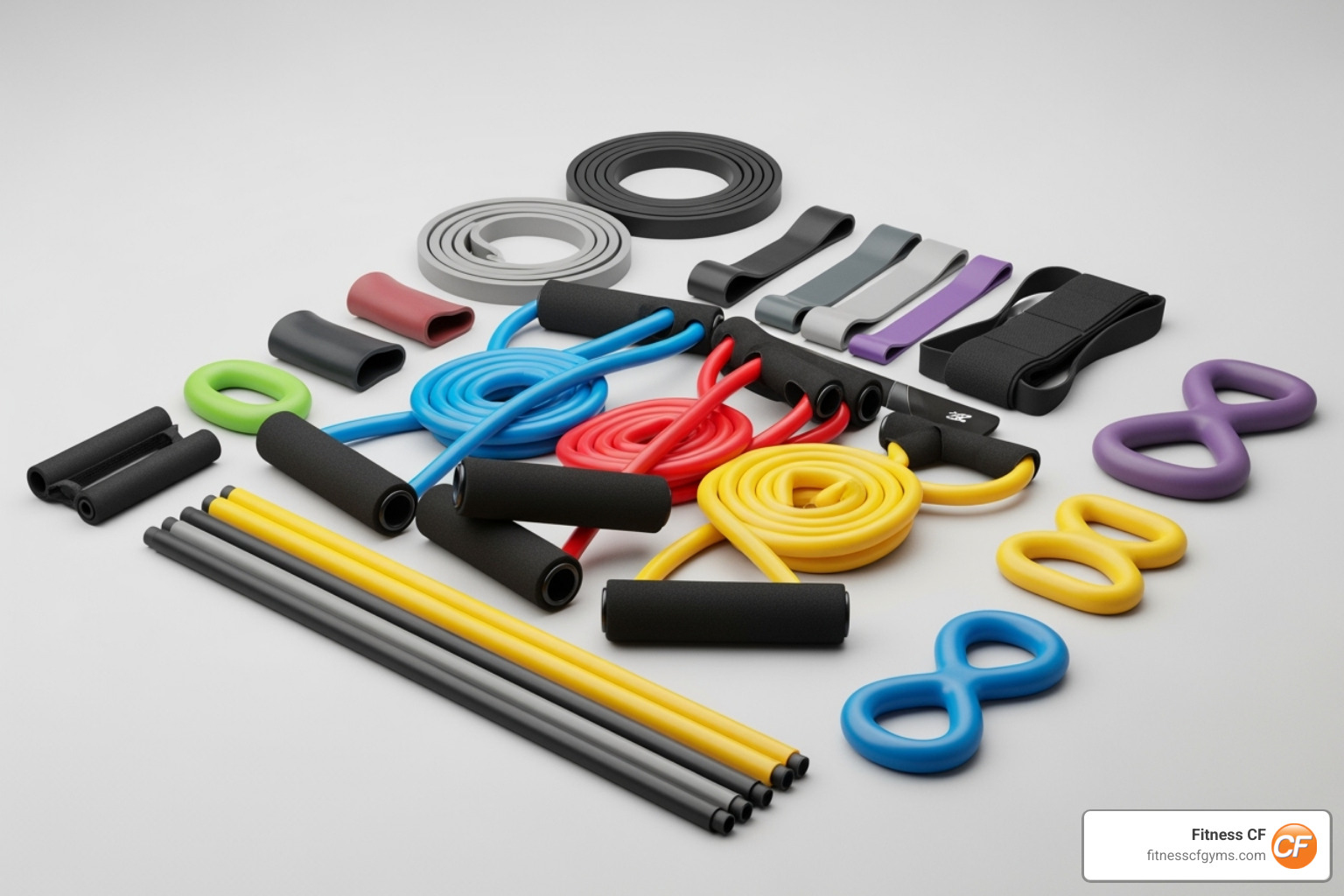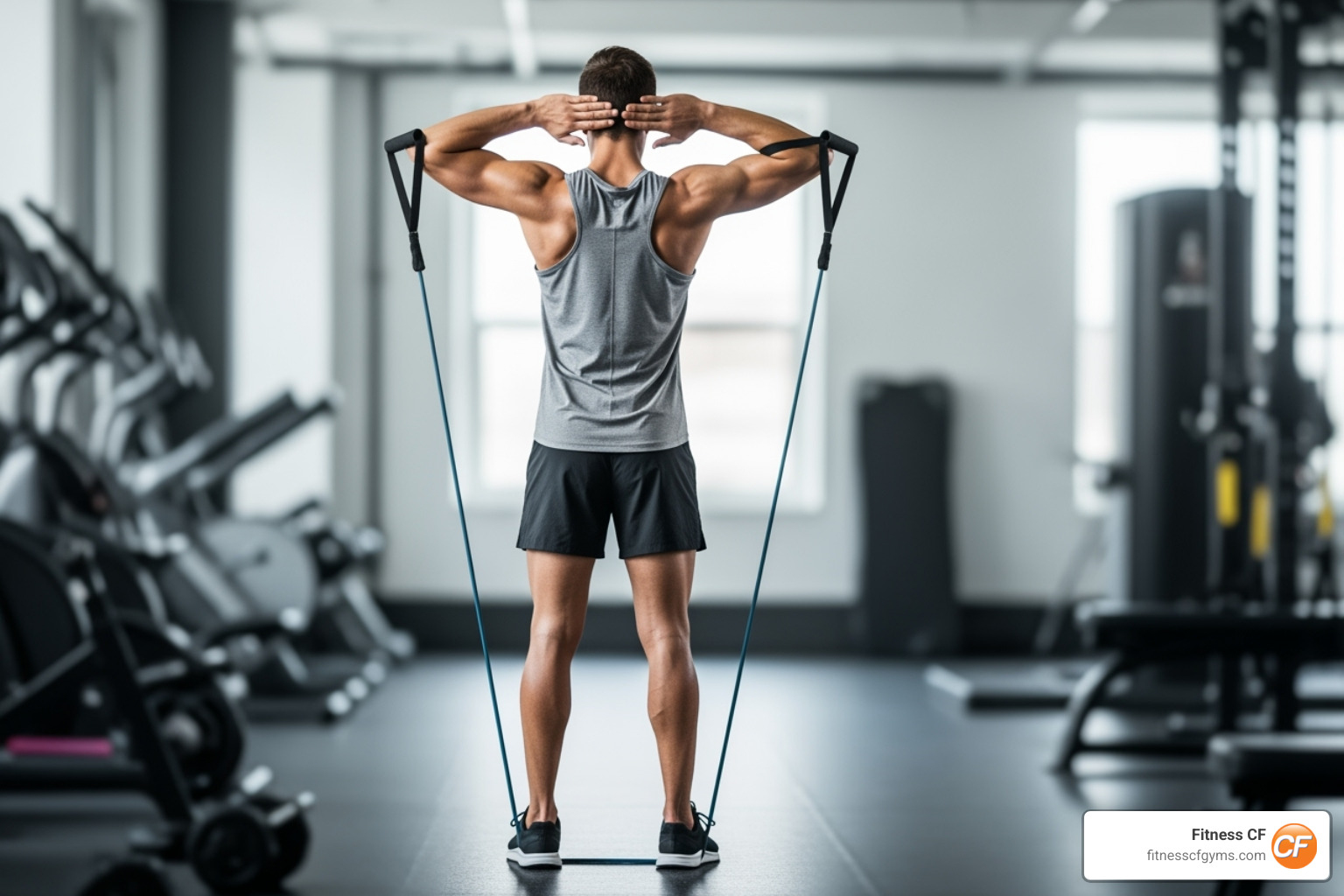Why Weight Bands for Arms Are Taking Over Home Fitness
Weight bands for arms are a popular choice for effective home workouts. These versatile tools provide constant tension, keeping your muscles engaged throughout the entire range of motion—an advantage traditional weights can’t match.
Top 5 Weight Bands for Arms:
- Loop Bands – Perfect for lateral raises and shoulder exercises
- Tube Bands with Handles – Best for bicep curls and triceps extensions
- Figure-8 Bands – Ideal for chest and arm isolation work
- Therapy Bands – Great for rehabilitation and light resistance
- Heavy-Duty Bands – Built for serious strength training and muscle building
Research shows resistance bands can activate muscles as effectively as dumbbells for upper-body exercises. Their constant tension makes them suitable for all fitness levels. The beauty of weight bands lies in their simplicity, effectiveness, and portability. You can get a complete arm workout anywhere without bulky equipment.
As Pleasant Lewis, owner of Fitness CF with over 40 years in the fitness industry, I’ve seen countless clients achieve incredible arm strength and definition using weight bands for arms in their home routines. These tools have revolutionized how busy Central Florida residents can maintain their fitness goals while balancing work and family life.

Why Choose Weight Bands for Arms?
Wondering if weight bands for arms live up to the hype? They offer serious advantages for building stronger, more defined arms.
Constant tension is the biggest difference. Unlike dumbbells, bands keep your muscles engaged throughout the entire movement. During a bicep curl, your muscles work just as hard at the top as at the bottom, leading to better results in less time.
The smooth, elastic resistance is also gentler on your joints than the impact of heavy weights. This makes bands perfect for those with joint issues, recovering from injury, or anyone preferring a lower-impact approach to strength training.
Let’s not forget portability and affordability. A full arm workout can fit in a bag or desk drawer, with no gym membership or bulky equipment needed. A quality set of bands costs less than a single dumbbell, making strength training accessible to all.
Most importantly, research from the Journal of Human Kinetics confirms that bands activate upper-body muscles just as effectively as traditional weights. Your muscles respond to resistance, whether from a band or a dumbbell. This is key, as arm strength is vital for overall health, a topic we explore in our guide on Why Arm Strength Is Important for Overall Fitness.
The Science of Variable Resistance
Weight bands for arms provide variable resistance: the resistance increases as you stretch the band. This means a bicep curl gets progressively harder as you lift.
This creates more time under tension, keeping your muscles working longer through both the contracting (concentric phase) and lengthening (eccentric phase) parts of the movement. Increased time under tension recruits more muscle fibers and creates metabolic stress, both of which are key triggers for muscle growth. A 2021 study in Sports Medicine confirmed that resistance bands can produce significant strength increases, proving their effectiveness.
Comparing Bands to Free Weights
Weight bands for arms and dumbbell workouts aren’t an either-or choice. Both are valuable, but bands have unique advantages.
Dumbbells provide consistent resistance due to gravity. Bands offer increasing, or variable, resistance, challenging your muscles differently. This variable resistance also promotes better form, as you can’t use momentum to cheat. You must control both the lifting and lowering portions of each exercise, building more functional strength for daily life.
For injury prevention, bands have a clear edge. The elastic resistance is smoother and easier on joints and connective tissues. While dumbbells are great for building raw strength, bands excel at improving mobility and muscle coordination. The best approach often involves combining both. To learn more about dumbbells, check out our guide on 10 Simple Dumbbell Exercises for a Full Body Workout.
A Guide to the Different Types of Arm Bands
When you’re ready to use weight bands for arms, understanding the different types will help you build the perfect collection for your workouts.

- Tube bands with handles: These classic bands have soft grips, making them ideal for bicep curls and triceps extensions. They mimic the feel of gym cable machines.
- Loop bands: Also called power bands, these continuous circles of rubber are versatile. They are great for exercises where you anchor the band, such as lateral raises and overhead pull-aparts.
- Figure-8 bands: Their unique shape with grips and loops is perfect for isolation exercises that target arms and shoulders from unique angles.
- Therapy bands: These wide, flat strips offer light resistance, making them ideal for rehabilitation, stretching, and mobility exercises.
How to Choose the Right Weight Bands for Your Arms
Choosing the right weight bands for arms is about matching the band to your fitness level and goals.
Most bands use a color-coding system for resistance levels (e.g., lighter colors for lighter resistance). Find a band that challenges you on the last two reps of a set without compromising your form. If it’s too easy, move to a heavier band. If your form breaks, use a lighter one.
Investing in a set with varying resistance levels is the smartest approach. This allows you to use the appropriate resistance for different exercises and to progress as you get stronger. Whether your goal is toning or hypertrophy (muscle growth), having options is key. If you’re just starting, our guide on How to Start Your Fitness Journey can help you build a strong foundation.
Adjusting Intensity for Progressive Overload
Progressive overload—continuously challenging your muscles—is key to strength training. With weight bands for arms, you can easily increase intensity in several ways:
- Change bands: The simplest method. As you get stronger, move to a band with higher resistance.
- Adjust your grip: Grip the band closer to the anchor point or widen your stance to shorten the band’s working length, increasing tension.
- Shorten the band: Wrap the band around your hand or anchor point an extra time to increase the challenge.
- Combine bands: Layer two bands together to create custom resistance levels.
- Adjust reps and sets: Increase from 8-12 reps to 12-15, or add an extra set. For most arm exercises, aim for 2-3 sets of 8-25 reps.
- Increase time under tension: Slow down your movements, especially the return phase, and hold the peak contraction for a few seconds.
The Ultimate Arm Workout with Resistance Bands
To maximize your weight bands for arms workout, focus on proper form. Control each movement, keep your core engaged, maintain a straight back, and avoid using momentum. Breathe correctly: inhale to prepare, exhale during the exertion.
Always warm up before and cool down after your workout to prevent injury and improve performance. For guidance, see The Importance of Warm-Up and Cool-Down Exercises: A Comprehensive Guide.
Perform each exercise for 10-12 repetitions, moving between exercises with minimal rest. Complete the circuit 2-3 times.
Biceps Blasting Exercises
These exercises build bicep strength and definition.
Standing Bicep Curls: Stand on your band with feet shoulder-width apart. Hold the handles with palms forward, elbows tucked at your sides. Slowly curl your hands toward your shoulders, squeezing your biceps at the top for 2-3 seconds. Lower slowly, resisting the band’s pull.

Concentration Curls: Sit on a bench or chair. Place the band under one foot and hold the end with the same-side hand, resting your elbow on your inner thigh. Curl the band toward your shoulder, focusing on the bicep squeeze. This position isolates the muscle.
Reverse Grip Curls: Perform a standing bicep curl, but with your palms facing down. This variation targets your forearms and the brachialis muscle, adding to overall arm thickness.
Triceps Toning Exercises
Your triceps make up two-thirds of your upper arm, so don’t neglect them.
Overhead Triceps Extensions: Stand on your band. Grab the handle(s) with both hands and extend your arms overhead. With the band behind your neck and elbows pointing forward, press the band straight up by extending your forearms. Squeeze your triceps at the top, then lower slowly.

Triceps Kickbacks: Take a staggered stance with the band under your front foot. Hinge forward at the hips with a straight back. Hold the handle with your upper arm parallel to the ground and elbow bent at 90 degrees. Extend your arm straight back, squeezing your triceps. Keep your upper arm still.
Single-Arm Triceps Extension: Stand on the band with one foot, holding the handle in the same-side hand. Extend your arm overhead, elbow close to your head. Lower your hand behind your head by bending at the elbow, then extend back up, squeezing the triceps.
Shoulder Sculpting Exercises
Strong shoulders contribute to overall arm strength and functionality.
Overhead Press: Stand on your band, feet shoulder-width apart. Grip the handles at shoulder level, palms forward. Press straight overhead until your arms are fully extended. Pause for 2 seconds, then slowly lower.
Lateral Raises: Stand on your band, holding handles at your sides with palms in. With a slight bend in your elbows, lift your arms out to the sides until parallel to the floor (a “T” shape). Hold for 2-3 seconds, then lower slowly.
Front Raises: Stand on your band, handles in front of your thighs, palms facing your body. Keeping arms straight, lift them forward until parallel to the floor. Hold for 2-3 seconds, then slowly lower.
Band Pull-Aparts: Hold a lighter loop band with both hands, arms straight out at shoulder height. Squeeze your shoulder blades together to pull the band apart until it touches your chest. Return slowly. This is excellent for posture and shoulder health.
Strength training with weight bands for arms offers muscle-building benefits while being gentle on your joints. For more ideas, explore our guide: How to Build Arm Muscle: 10 Workouts You Have to Try.
Integrating Bands into Your Fitness Routine
Weight bands for arms are versatile, working well on their own or as part of a larger fitness plan.
For best results, work your arms with resistance bands 2 to 3 times per week, allowing for at least one rest day in between. Muscle growth happens during recovery, so rest is crucial for seeing progress. You can easily incorporate these arm exercises into full-body workouts.
A great approach is combining bands with cardio. After a brisk walk or run, do a quick 10-minute arm circuit with your bands. This combination supports healthy living by maximizing your time and boosting your metabolism. Their portability ensures you can stay consistent at home, while traveling, or on a lunch break. To learn more about balancing strength and cardio, read our guide on Strength Training vs. Cardio: Which Is Better for Weight Loss?.
Common Mistakes to Avoid When Using weight bands for arms
Avoid these common pitfalls to ensure your workouts are effective and safe.
- Poor form: Don’t swing your arms or use momentum. Focus on smooth, controlled movements with an engaged core.
- Wrong resistance: If you can breeze through 15 reps, use a heavier band. If you can’t complete 5 reps with good form, choose a lighter one.
- Not controlling the movement: The lowering phase of an exercise is crucial for muscle building. Resist the band’s pull instead of letting it snap back.
- Snapping the band: Inspect your bands for nicks or wear before each workout. Ensure your grip and anchor points are secure.
- Rushing through reps: Slow, deliberate movements create more time under tension, which is what your muscles need to grow stronger.
Using weight bands for arms in Rehabilitation
Weight bands for arms are excellent for rehabilitation after injury or surgery.
Their low-impact training provides smooth, controlled resistance that is gentle on healing joints and tissues. Bands are particularly effective for strengthening stabilizer muscles around your joints, which is vital for stability and preventing future issues, especially for rotator cuff health.
Using bands also naturally improves mobility by encouraging a full range of motion with gentle resistance. Physical therapists often use them because they can mimic real-life activities, preparing your muscles for everyday challenges. If you’re considering professional guidance, our article on The Benefits of Personal Training: Tailoring Your Fitness Journey explains how personalized support can help.
Frequently Asked Questions about Arm Resistance Bands
Here are answers to the most common questions about weight bands for arms.
Can you really build muscle with just resistance bands?
Yes, you can absolutely build muscle and strength using only weight bands for arms. The key is applying progressive overload (gradually increasing the challenge) and maximizing time under tension. Bands provide constant tension throughout each movement, which is a powerful stimulus for muscle growth (hypertrophy). Consistency and proper form are essential.
How often should I do arm workouts with resistance bands?
Aim for weight bands for arms workouts 2 to 3 times per week. It’s crucial to include at least one rest day between sessions to allow for muscle recovery and growth. Listen to your body; if you feel excessively sore, take an extra rest day.
Are resistance bands better than dumbbells for arms?
It’s not about which is “better.” Resistance bands and dumbbells are both effective and can complement each other well.
Weight bands for arms provide variable and constant tension, challenging muscles in a unique way. They are also portable, affordable, and exceptionally joint-friendly. Research confirms they can activate upper-body muscles as effectively as dumbbells.
Dumbbells excel at building raw, measurable strength. The best choice depends on your goals, lifestyle, and preferences. Using both can provide a well-rounded approach to arm training.
Conclusion
Weight bands for arms have revolutionized strength training, making effective workouts accessible to everyone, anywhere. Their simplicity and effectiveness are best. They provide constant tension, promote functional strength, and are gentle on your joints while delivering serious results.
From our experience at Fitness CF, we’ve witnessed countless individuals transform their arms and boost their confidence using these simple yet powerful tools. The constant tension and variable resistance are perfect for busy lifestyles.
Consistency is key. Start with the right resistance, focus on proper form, and apply progressive overload as you get stronger. Your journey to stronger, more defined arms doesn’t require expensive equipment or a gym membership. With weight bands for arms, you have everything you need for an incredible workout that fits your daily routine.
Ready to take your fitness to the next level? We’d love to support you on your journey. Explore your fitness potential with us and find how we can help you achieve your goals.







